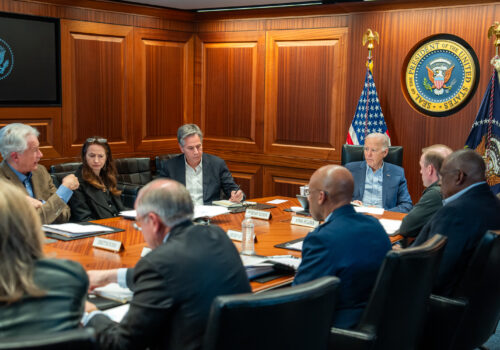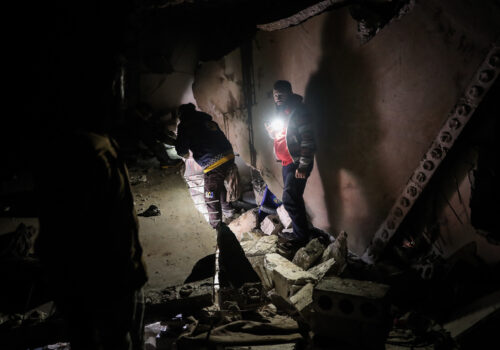Experts react: What the New Orleans attack tells us about terrorism in 2025
It was a somber start to 2025. In the early hours of New Year’s Day, a man drove a pickup truck through throngs of pedestrians on Bourbon Street in New Orleans, leaving fourteen dead and injuring at least thirty others. The Federal Bureau of Investigation (FBI) said Thursday that the driver, Shamsud-Din Jabbar, acted alone and was inspired by the Islamic State of Iraq and al-Sham (ISIS). What does the attack reveal about ISIS and the state of global terrorism as 2025 begins? What policy implications are there for the incoming Trump administration? Our counterterrorism experts are on the case.
Click to jump to an expert analysis:
Marc Polymeropoulos: A lone wolf is far more dangerous than a terrorist cell
Danielle Cosgrove: The attack shows the evolving threat of ISIS’s Digital Caliphate
Morgan Tadych: The attack indicates a troubling pattern of online radicalization
Doug Livermore: ISIS is diminished in the Middle East, but is persisting elsewhere
Mike Nelson: The US must remain vigilant against the appeal of ‘leaderless jihad’
A lone wolf is far more dangerous than a terrorist cell
As the investigation unfolds in New Orleans, I get a sense that some in the media and law enforcement are a bit relieved that this may “just” be the work of a lone wolf attacker. It may be counterintuitive, but I’d argue that a lone wolf is far more worrisome and dangerous for US counterterrorism officials, as it is so much harder for both law enforcement and the intelligence community to penetrate the operation itself. This is exacerbated further if the attacker self-radicalized, receiving inspiration and guidance virtually from ISIS propaganda, for example.
Officials in the counterterrorism world actually prefer to investigate terrorist cells, as this provides significant opportunities to uncover and recruit the cell members, and also potentially intercept communications between cell members and the terrorist mothership. The more individuals involved in a terrorist plot, the larger chance that one makes a mistake. While of course it would be a relief to know that there are not ISIS adherents running around New Orleans posing a direct public safety threat, we should not rest easy, as this modus operandi of a lone wolf conducting a vehicle attack poses immense challenges to the traditional detect/disrupt/deter counterterrorism model that has worked so effectively in the past.
—Marc Polymeropoulos is a nonresident senior fellow in the Forward Defense practice of the Atlantic Council’s Scowcroft Center for Strategy and Security and a member of the Council’s Counterterrorism Project. He worked for twenty-six years at the CIA in a variety of field and headquarters operational assignments focusing on counterterrorism, the Middle East, and South Asia.
The attack shows the evolving threat of ISIS’s Digital Caliphate
Following their formal defeat by coalition forces in 2019, the Islamic State leveraged its technological expertise to establish a Virtual Caliphate—a digital refuge where disaffected individuals seeking community and purpose converge around the vision of a state governed by sharia law under a caliph. The Virtual Caliphate has expanded rapidly, driven by shifting refugee populations, unresolved border disputes, decentralized planning needs, the use of generative AI as a knowledge hub, and the role of protests.
The Digital Caliphate signifies a new chapter in ISIS’s technological evolution, building on the Virtual Caliphate by advancing from the dissemination of ideas to the orchestration of action and violence through digital and technological means. In essence, the Digital Caliphate bridges the proliferation of ideas with the execution of actions through digital tools.
The New Year’s attack in New Orleans highlights the evolving threat of the Digital Caliphate. The attacker’s actions reflect its hallmarks, including likely radicalization via unregulated platforms. The shift from physical territories to digital domains has made it harder to detect and disrupt lone actors operating independently but aligned with extremist ideologies.
This attack serves as a stark reminder that extremism has fully adapted to the digital age. The United States’ counter-strategies must evolve at scale and speed. Policymakers must act decisively to disrupt the Digital Caliphate’s ability to weaponize commercial technology and protect communities from future attacks.
—Danielle Cosgrove is a member of the Atlantic Council’s Counterterrorism Project as well as a technology executive and distinguished lecturer at Stanford University who previously led high-impact conflict zone operations and strategic stability initiatives.
The attack indicates a troubling pattern of online radicalization
The terror attack on our homeland on New Year’s Day shares several horrifying characteristics with other recent terror arrests made in the United States and Canada. In all three cases, men disaffected with their lives started to interact online with ISIS-linked influencers and sites. While the specifics of Jabbar’s online interactions are not yet clear, the presence of an ISIS flag in his rental truck in addition to early reports of videos that he posted promoting extremist content indicate that he was radicalized online. Prior to the last few years, Jabbar appeared to lead a relatively normal life; as his personal life fell apart, he became further radicalized.
In particular, Islamic State-Khorasan (IS-K, the Central Asia/Afghanistan-based branch of ISIS) has demonstrated a particular social media savvy to expand its Digital Caliphate. In several foiled attack plots in 2024, IS-K leveraged online contact with men seeking an Islamic community to radicalize and encourage them to commit attacks against symbolic Western targets. The New Orleans attack follows a similar pattern, with a recently radicalized US citizen terrorizing a symbolic soft target that is in opposition to IS-K’s perception of morality. The United States must monitor online spaces to attempt to detect and deter radicalization before it happens—in cases such as this, it is critical to stay “left of boom.”
—Morgan Tadych is an open-source intelligence (OSINT) professional, Army veteran, and member of the Atlantic Council’s Counterterrorism Project. She spent much of her military career researching strategic Russia/Eurasia issues and deployed to conduct counterterrorism missions.
ISIS is diminished in the Middle East, but is persisting elsewhere
ISIS’s territorial caliphate in the heart of the Middle East has largely crumbled and the group’s continued influence now relies on various “provinces” across the globe, from the Sahel to Afghanistan. These affiliates continue to pose notable challenges, surviving in regions marked by instability, weak governance, and other active insurgencies.
Throughout 2022, I served as the deputy commander of the NATO Special Operations Advisory Group in Iraq, a role in which I worked closely with the Iraqi Counter Terrorism Service and Federal Intelligence and Investigations Agency to root out the few legitimate ISIS fighters hiding out in caves in the mountainous north. Despite the group’s increasingly diminished capacity in Iraq and Syria, it continues to exploit the fragmented security environments there and elsewhere to persist despite international pressure. In the Sahel, ISIS affiliates compete with other larger terrorist groups for influence, while IS-K, operating in Afghanistan, remains a small but persistent threat to regional security—as was seen in the Moscow attack of March 2024.
Iran has strategically used ISIS as a bogeyman to justify its malign activities in the region, particularly its influence in Iraq and, until recently, Syria. By portraying itself as a bulwark against the return of ISIS, Iran aims to maintain its presence and control over strategic territories, consolidating its influence among local militias and proxy groups. This dangerous narrative obscures Iran’s broader regional ambitions and its role in exacerbating the very conditions that foster extremism. This ongoing dynamic allows Iran to continue using proxies to smuggle weapons and launch attacks against Israel and threaten other interests from within Iraqi territory.
Even though ISIS is a diminishing shell of its former self, it still bears continued attention given both the exploitation of its existence by strategic competitors and potential for resurgence.
—Doug Livermore is a member of the Atlantic Council’s Counterterrorism Group, national vice president for the Special Operations Association of America, senior vice president for solution engineering at the CenCore Group, and the deputy commander for Special Operations Detachment—Joint Special Operations Command in the North Carolina Army National Guard.
The US must remain vigilant against the appeal of ‘leaderless jihad’
The New Orleans attack represents the latest in a series of attacks and threats that have plagued the United States and its allies for decades. In the immediate aftermath of the attack, there was speculation that this was an act of a larger cell or potentially a complex attack with improvised explosive devices placed as a second wave. Perhaps this was part of a multicity simultaneous attack connected to the bizarre events in Las Vegas. However, while details are still emerging, it appears that this was a tragic but unsophisticated attack by a solo actor who had recently become more radicalized by digital messaging and content against a soft target. In many ways, it was reminiscent of attacks like those in San Bernardino in 2015 and Orlando in 2016, in that the perpetrators were individually radicalized and inspired by Islamist jihadism as opposed to being directed by larger organizations or conducting attacks that required specialized training. Jabbar’s status as a veteran is reminiscent of the attacks of Sergeant Hasan Akbar and Major Nidal Hasan, in that those who had volunteered to serve the United States became influenced to attack it.
These kinds of attacks are the manifestation of al-Qaeda strategist Abu Musab al-Suri’s concept of “leaderless jihad,” that mujahideen distributed throughout the world would take it upon themselves to conduct attacks against enemies near and far. They are potentially the hardest to anticipate in that there are no cells to infiltrate, no specialty items or explosives to trigger attention, and, given that Jabbar was a native-born US citizen, no immigration screening to have blocked the threat at the border.
The attack should not be taken as an indication of re-emerging ISIS strength, rather as what appears to be the radicalization of an imbalanced malcontent. The danger, however, is that there are many more who are susceptible to this kind of extremism. As such, the United States must remain vigilant against all forms of radical Islamism—both the armed formations and the online influence operations.
—Mike Nelson is a retired Army special forces officer and a member of the Atlantic Council’s Counterterrorism Project.
Further reading
Wed, Nov 13, 2024
Integrated strategic competition: A new approach to US national security
MENASource By
In this evolving landscape, there is a pressing need for a renewed and coherent multi-agency approach that truly integrates the instruments of national power.
Thu, Nov 7, 2024
Managing counterterrorism foreign liaison relationships in an increasingly competitive world
MENASource By
Robust investment in foreign liaison relationships enables the fundamental conditions required for an effective global counterterrorism strategy, and not just within the countries where these partnerships are enabled.
Wed, Oct 23, 2024
Balancing a culture of secrecy and collaboration: Information sharing with hostage families
MENASource By
US policies enshrine a requirement for intelligence sharing between the US government and hostage families.
Image: Law enforcement members work at the site where people were killed by a man driving a truck in an attack during New Year's celebrations, in New Orleans, Louisiana, U.S., January 2, 2025. REUTERS/Eduardo Munoz


